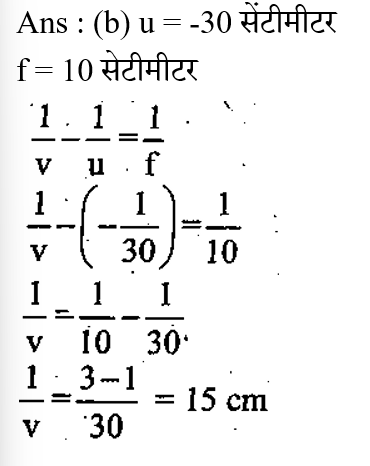Question 1: 
Question 2:
Which part of human brain controls the involuntary action of vomiting?
मानव मस्तिष्क का कौन सा भाग उल्टी (Vomiting) की अनैच्छिक क्रिया को नियंत्रिक करता है।
Question 3:
Negative acceleration is opposite to the direction of which of the following?
नकारात्मक त्वरण निम्न में से किसकी दिशा के विपरीत होता है?
Question 4:
What will be the colour of litmus solution when mixed with sulphuric acid?
सल्फ्यूरिक एसिड के साथ मिश्रित होने पर लिटमस विलयन का रंग कैसा बनेगा?
Question 5:
An object is placed on the principal axis of a convex lens having a focal length of 10 cm. If the distance of the object from the lens is 30 cm, at what distance will the image be formed?
एक वस्तु को 10 सेंटीमीटर की फोकल लंबाई वाले एक उत्तल लेंस के मुख्य अक्ष पर रखा जाता है। यदि लेंस से वस्तु की दूरी 30 सेंटीमीटर है, तो प्रतिबिंब कितनी दूरी पर बनेगा ?
Question 6:
The fetus receives nutrition from the mother's blood with the help of a special tissue:
भ्रूण को एक विशेष ऊतक की सहायता से माँ के रक्त से पोषण प्राप्त होता है:
Question 7:
Why is the filament of an electric bulb usually made of tungsten?
विद्युत बल्ब का सूत्र ( फिलामेंट) आमतौर पर टंगस्टन का क्यों होता है?
Question 8:
Which of the following is an example of a hydrocarbon?
निम्न में से क्या हाइड्रोकार्बन का एक उदाहरण है?
Question 9:
Based on the content of carbon and moisture, what are the highest and lowest quality varieties of coal respectively?
कार्बन और नमी की मात्रा के आधार पर कोयले की उच्चतम और निम्नतम गुणवत्ता वाली किस्में क्रमश: कौन सी है ?
Question 10:
Which of the following scientists had done some calculations for the fifth state of matter?
निम्नलिखित में से किस वैज्ञानिक ने पदार्थों की पांचवीं अवस्था के लिए कुछ गणना की थी?


